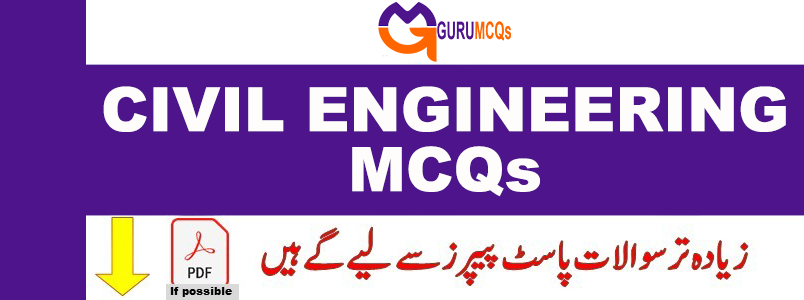
GURU MCQs provides Civil Engineering MCQs for Job Test and Interview Preparation, suitable for fresh graduates, students, and competitive exams. Most repeated civil engineering MCQs section is frequently encountered in CSS, PMS, Inspector, ASI, Sub-Inspector, Constable, FPSC, PPSC, ETEA, FIA, Police, Army, Navy, Airforce, IB, MOFA, ASF, LHC, Educators, and various other competitive exams, as well as government and private job assessments. The most common updated MCQs include Basic Civil Engineering, Building Materials, Surveying, Soil Mechanics and Foundation Engineering, Applied Mechanics, Hydraulics, Waste Water Engineering, RCC Structures Design, Irrigation, Railways, Construction Management, Theory of Structures, Estimating and Costing, Docks and Harbours, Elements of Remote Sensing, Building Construction, Concrete Technology, Advanced Surveying, Strength of Materials, Water Resources Engineering, Water Supply Engineering, Steel Structure Design, Highway Engineering, Airport Engineering, Structural Design Specifications, Tunnelling, and much more.
31. Dead Slow” is a______________?
A. regulatory sign
B. warning sign
C. informatory sign
D. none of the above
32. The provision of traffic signals at intersections______________?
A. reduces right angled and rear end collisions
B. increases right angled and rear end collisions
C. reduces right angled collisions but may increase rear end collisions
D. reduces rear end collisions but may increase right angled collisions
33. The particular places where pedestrians are to cross the pavement are properly marked by the pavement marking known as________________?
A. stop lines
B. turn markings
C. crosswalk lines
D. lane lines
34. When two equally important roads cross roughly at right angles, the suitable shape of central island is________________?
A. circular
B. elliptical
C. tangent
D. turbine
35. Centre line markings are used_____________?
A. to designate traffic lanes
B. in roadways meant for two way traffic
C. to indicate that overtaking is not permitted
D. to designate proper lateral placement of vehicles before turning to different directions
36. The entrance and exit curves of a rotary have_______________?
A. equal radii and equal widths of pavement
B. equal radii but pavement width is more at entrance than at exit curve
C. equal pavement widths but radius is more at entrance curve than at exit curve
D. different radii and different widths of pavement
37. The maximum number of vehicles beyond which the rotary may not function efficiently is______________?
A. 500 vehicles per hour
B. 500 vehicles per day
C. 5000 vehicles per hour
D. 5000 vehicles per day
38. As per IRC recommendations, the average level of illumination on important roads carrying fast traffic is______________?
A. 10 lux
B. 15 lux
C. 20 lux
D. 30 lux
39. Maximum number of vehicles can be parked with_______________?
A. parallel parking
B. 30° angle parking
C. 45° angle parking
D. 90° angle parking
40. A traffic rotary is justified where______________?
A. number of intersecting roads is between 4 and 7
B. space is limited and costly
C. when traffic volume is less than 500 vehicles per hour
D. when traffic volume is more than 5000 vehicles per hour

Pingback: Software Engineering MCQs for Preparation - GURU MCQS